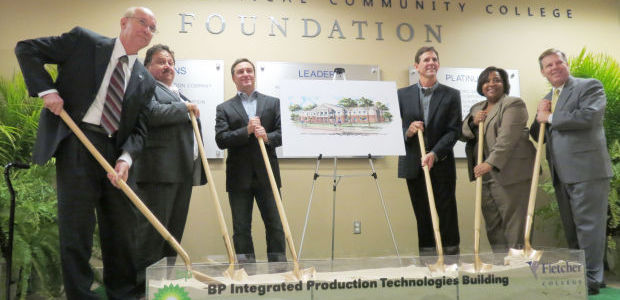
Readying for ‘Future of American energy’
January 16, 2013Lafourche port commissioners sworn into office
January 16, 2013Gulf of Mexico energy development stakeholders expressed optimism toward the industry’s future Monday, as the president of a Louisiana oil-and-gas advocacy group addressed local leaders at the monthly Bayou Industrial Group luncheon.
Louisiana Mid-Continent Oil and Gas Association President Chris John said the oil and gas industry anticipates to continue its resurgence in the Gulf of Mexico since the BP oil spill nearly three years ago and expects to conduct record-level business off the Gulf Coast within the next couple of years.
“In speaking to the vice president of offshore operations for the Gulf of Mexico for Shell, he believes – and there was an article in a national publication that said – by 2015, they’re predicting 60 – 60 – drill ships in the Gulf of Mexico. That’s huge,” John said. “There are some real bullish thoughts coming out of people that know what they’re talking about with the Gulf of Mexico in a lot of ways.
John said 33 rigs are operating in the Gulf, as are roughly 35 drill ships. Both numbers are in sync with pre-Deepwater Horizon levels, speaking loudly of the industry’s recovery following the permitting and activity lulls through the better part of 2011.
“The principles of supply and demand outweigh political preferences,” John said after his 35-minute presentation. The “energy reality,” he stressed, is that the United States uses 20 million barrels of oil per day while producing domestically 6 million barrels per day.
This cultural want and dependence begs the development of oil and gas sources, because wind, solar and other alternative, cleaner sources make up less than 2 percent of energy use, he said.
The fatal ecologically disastrous BP Deepwater Horizon explosion and oil release in 2010 was followed by a presidentially imposed ban on offshore oil and gas development. After the moratorium was lifted, exploration and development permits still only trickled out.
During this period, elected officials and industry spokespeople routinely floated the idea that companies would pack up and leave the politically precarious Gulf of Mexico for less-restricted waters if regulators did not reopen the waters for business.
Regulators insisted the permitting delays were of no nefarious intent, as they responded to the largest oil spill in the nation’s history by enforcing stricter safety policies.
Now, seven days before Obama is inaugurated for his second term, the language has changed: There was no exodus, and it appears offshore industry is around the corner, staring into a bright future.
Although it’s limiting to diagnose the Gulf of Mexico’s vitality strictly by the number of deep-water permit approvals, permit issuance for new wells in waters deeper than 500 feet has eclipsed pre-Deepwater Horizon rates.
Over a one-year span ending Jan. 10, 2013, federal regulators have approved more new well permits in the deep-water Gulf than they did during any similar timeframe since they began cataloguing the statistics online in April, 2004.
The 111 new well permits over the last year are rivaled only by 107 issued from 2007-08 and 96 from 2006-07, according to figures from the Bureau of Safety and Environmental Enforcement.
In the shallow-water Gulf, the numbers have yet to see a post-Macondo bump. Sixty-nine new well permits were approved in the same January-to-January timeframe ending 2013, three less than the period ending 2012 and one more than the period ending 2011, according to BSEE figures.
For the yearly windows ending in 2010, 2009 and 2008, new well approvals in the shallow water totaled 95, 197 and 234.
Wells thought to be mature in the shallow depths have received more attention as of late, as companies seek to squeeze what they can from below.
But Chett Chiasson, director of the Greater Lafourche Port Commission, which handles roughly 90 percent of deep-water activity in the Gulf of Mexico, said issuance might be linked to permit application in this case.
That rate is down, he surmised, as companies watch with interest as the risk-taking company McMoran Exploration works on technology to recover ultra-deep liquid natural gas from shallow-water depths.
Coupled with the high rate of deep-water permit issuance that has closeted the phrases “job-killing moratorium” and the so-called or “de facto moratorium” that followed, ultra-deep drilling for natural gas in shallow depths could spark growth beyond the Gulf’s resurgence over the last year, Chiasson and John said separately.
John said the state’s historical experience in Gulf of Mexico development, and the infrastructure (125,000 miles of pipeline, he said) and technology that comes with it, has the state in a good position as new extraction methods are hashed out.
“Now the new interest on shallow-water, deep wells, I think here in Louisiana we are really poised and primed to really benefit in a big way from the next generations of oil and gas production,” John said.










